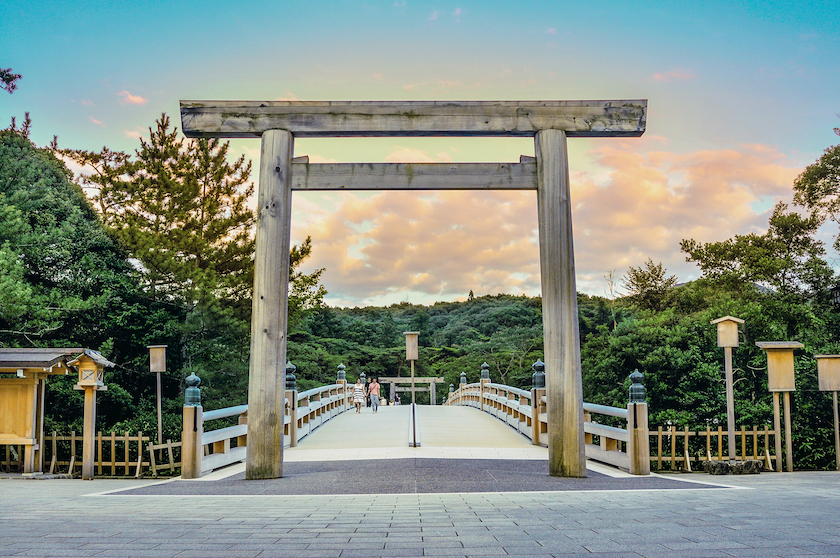Ise Grand Shrine: Complete Guide to Visiting Japan’s Sacred Shrine in Mie Prefecture

History and Ancient Legends of Ise Grand Shrine: From Origins to Present Day
The Ise Grand Shrine, with a history spanning nearly two thousand years, stands as one of Japan’s most sacred and ancient religious sites. It has long been a symbol of the nation’s spiritual heritage and cultural identity. According to ancient legends, the shrine was established during Japan’s early imperial era as the sacred dwelling of Amaterasu, the Sun Goddess. This rich history demonstrates how traditional rituals and beliefs have been preserved and passed down through generations at this revered location.
Over the centuries, the Ise Grand Shrine has witnessed significant historical events, including periods of war, peace, cultural transformation, and political change, all of which have influenced its architecture and spiritual significance. Various narratives, from mythological stories to historical accounts, reveal that the shrine is not only a place of worship but also a unifying symbol of Japan’s collective identity and national unity.
Today, the Ise Grand Shrine is recognized as a UNESCO World Heritage site and a cultural treasure of Japan. Millions of visitors from around the world travel to experience its spiritual ambiance and historical grandeur. Its enduring legacy underscores its vital role in shaping and maintaining Japan’s cultural and spiritual heritage across millennia.
Unique Architecture and Sacred Construction Techniques of Ise Shrine
The architecture of the Ise Grand Shrine is renowned for its distinctive style called “Shinmei-zukuri,” which dates back over a thousand years. This style emphasizes simplicity, natural materials, and spiritual purity. Constructed primarily from durable cypress wood, the shrine is built without nails, using traditional joinery techniques that showcase exceptional craftsmanship from ancient times.
A key secret of its architecture is the tradition of rebuilding the shrine every twenty years, a practice known as “Shikinen Sengu.” This ritual symbolizes renewal and the impermanence of the world, ensuring the preservation of traditional construction methods and spiritual values. Each reconstruction maintains the original design and spiritual essence, reflecting a deep respect for nature and the cycles of life.
Beyond the external design, intricate details inside the shrine, such as symbolic ornaments and structural elements like “Katsuogi” and “Chigi,” carry profound spiritual meanings. These architectural secrets have been handed down through generations, embodying the sacred craftsmanship that sustains the shrine’s spiritual integrity and cultural significance.
The Role and Significance of Ise Grand Shrine in Shinto Culture and Rituals
The Ise Grand Shrine serves as the central hub of Shinto worship, playing a crucial role in preserving Japan’s spiritual traditions and cultural identity. It is dedicated to Amaterasu, the Sun Goddess, and acts as a symbol of national unity and divine authority. Throughout the year, numerous ceremonies and festivals are held to honor the deities and reinforce community bonds.
In Japanese culture, the shrine epitomizes purity, renewal, and a direct connection to the spiritual realm. The “Shikinen Sengu” festival, held every twenty years, exemplifies the importance of renewal and spiritual continuity. These rituals are not only religious acts but also social and cultural events that strengthen the collective identity of the Japanese people.
Furthermore, the shrine’s influence extends into arts, literature, and national traditions, symbolizing respect for history and cultural heritage. The continuous participation of local communities and visitors in various ceremonies highlights the shrine’s enduring importance in shaping Japan’s cultural landscape and spiritual life.
The Cycle of Rebuilding Every 20 Years: Symbol of Life, Death, and Renewal
One of the most remarkable features of the Ise Grand Shrine is its tradition of rebuilding every twenty years, symbolizing the cycle of life, death, and rebirth. This ritual, known as “Shikinen Sengu,” involves carefully dismantling the old structures and reconstructing them using the original techniques and materials, often recycling the timber from the previous shrine.
This process underscores a profound respect for nature and the impermanence of material existence, embodying the Buddhist and Shinto philosophies of renewal. The rebuilding is a major cultural event, involving skilled artisans and the community, and it signifies the continuous renewal of spiritual and cultural vitality.
Through this tradition, the shrine preserves ancient craftsmanship and architectural techniques, passing them down through generations. It also serves as a powerful reminder of the importance of embracing change and renewal in life, reinforcing the spiritual message that life is a perpetual cycle of death and rebirth.
Hidden Secrets and Symbolic Elements Inside and Around Ise Shrine
The surroundings of the Ise Grand Shrine are filled with hidden symbols and sacred elements that reflect deep spiritual beliefs. Tall wooden fences and boundary markers delineate the sacred space from the mundane world, emphasizing reverence and the sanctity of the site. Access to the inner sanctuaries is restricted, often limited to high-ranking priests and imperial family members, symbolizing respect for divine purity.
Within the shrine complex, symbolic structures like “Katsuogi,” “Chigi,” and decorative ornaments on the roofs carry spiritual meanings related to divine protection and harmony with nature. These elements are not merely decorative but serve as visual representations of the divine connection and spiritual protection.
Surrounding the main shrine are sacred sites such as “Kojin-dani” and “Kami-tokora,” which house sacred objects and ritual artifacts. These hidden aspects and symbolic features reveal the profound spiritual depth of the shrine, preserved through centuries of tradition, and remain largely unseen by the general public, adding to its mystique and sacred aura.
Complete Guide to Visiting Ise Grand Shrine: Planning and Best Times to Visit
Planning a visit to the Ise Grand Shrine requires careful consideration of timing and logistics. The most favorable seasons are spring and autumn, when the weather is mild and the natural scenery is breathtaking. Visiting during festivals or special ceremonies offers a unique spiritual experience, allowing visitors to witness traditional rituals firsthand.
Accessible via efficient train routes and transportation networks, reaching the shrine is convenient for travelers. It is advisable to plan your trip ahead, including accommodations and nearby attractions, to ensure a smooth and enriching experience. Early mornings and weekdays are ideal for avoiding crowds and experiencing the serenity of the sacred site.
Remember to respect local customs, dress appropriately, and follow guidelines for sacred sites. Carrying necessary documentation and observing etiquette will enhance your spiritual journey, making your visit to Ise Grand Shrine memorable and meaningful.
Respectful Customs and Etiquette When Visiting Ise Grand Shrine
When visiting the Ise Grand Shrine, observing proper etiquette is essential to show respect for its sacred status. Before entering, bow slightly and offer a small prayer or bow at the torii gate, symbolizing reverence. Wash your hands and mouth at the purification fountain (“Temizuya”) to cleanse yourself spiritually before approaching the main shrine.
Inside the sacred grounds, avoid taking photographs in restricted areas and refrain from touching or disturbing sacred objects. When praying or making offerings, do so quietly and respectfully, maintaining a calm demeanor. These gestures reflect your respect for the divine and the spiritual atmosphere of the shrine.
Additional respectful practices include dressing modestly, refraining from loud conversations, and following the guidance of shrine staff. By adhering to these customs, visitors can ensure a respectful and spiritually enriching experience at the Ise Grand Shrine.
Festivals and Traditional Ceremonies at Ise Grand Shrine: Sacred Rites and Cultural Celebrations
The Ise Grand Shrine hosts numerous festivals and rituals throughout the year, each rich in symbolism and spiritual significance. The most prominent is the “Kinen-sai,” a festival held every twenty years during the rebuilding of the shrine, symbolizing renewal and divine continuity. Participants celebrate with traditional music, dance, and offerings to the deities.
In October, the “Kannamesai” festival marks the first harvest, where offerings are made to Amaterasu, expressing gratitude for nature’s bounty. This event features traditional performances, processions, and communal participation, reinforcing cultural bonds and spiritual devotion.
Other notable ceremonies include the “Shikinen Sengu,” the reconstruction festival, which involves elaborate rituals performed by priests and the community. These festivals preserve ancient traditions, foster community spirit, and deepen visitors’ understanding of Japan’s spiritual heritage, making each visit a profound cultural experience.
Frequently Asked Questions about Ise Grand Shrine
- What is the historical significance of Ise Grand Shrine?
- The Ise Grand Shrine, with nearly two thousand years of history, is one of Japan’s most sacred sites. It symbolizes the nation’s spiritual heritage and cultural identity, serving as the sacred residence of Amaterasu, the Sun Goddess, according to ancient legends. Over centuries, it has witnessed numerous historical events, including periods of war, peace, and cultural transformation, reinforcing its role as a unifying symbol of Japan’s collective identity. Today, recognized as a UNESCO World Heritage site, it attracts millions of visitors who seek to experience its spiritual and historical grandeur.
- What are the unique architectural features of Ise Shrine?
- The architecture of Ise Grand Shrine is renowned for its traditional “Shinmei-zukuri” style, emphasizing simplicity, natural materials, and spiritual purity. Constructed mainly from durable cypress wood without nails, it employs ancient joinery techniques. A distinctive aspect is the practice of rebuilding the shrine every twenty years, known as “Shikinen Sengu,” which preserves traditional craftsmanship and symbolizes renewal. Inside, elements like “Katsuogi” and “Chigi” carry deep spiritual meanings, reflecting the sacred craftsmanship passed down through generations.
- How does Ise Shrine play a role in Shinto rituals and culture?
- Ise Grand Shrine is the central hub of Shinto worship, dedicated to Amaterasu and serving as a symbol of national unity. It hosts numerous ceremonies and festivals, such as the “Shikinen Sengu,” which reinforce spiritual continuity and community bonds. The shrine embodies purity and renewal, with rituals that are both religious and cultural, fostering a sense of collective identity. Its influence extends into arts, literature, and traditions, making it a vital part of Japan’s spiritual and cultural landscape.
- What is the significance of rebuilding the shrine every 20 years?
- The tradition of rebuilding Ise Shrine every twenty years, called “Shikinen Sengu,” symbolizes the cycle of life, death, and rebirth. This ritual involves dismantling the old structures and reconstructing them using original techniques, often recycling timber from the previous shrine. It reflects respect for nature and the impermanence of material existence, embodying philosophies of renewal. This major event involves artisans and the community, emphasizing continuous spiritual and cultural renewal, and serves as a reminder of life’s perpetual cycles.
- What are some hidden symbols and sacred elements inside Ise Shrine?
- The surroundings of Ise Shrine are filled with hidden symbols like tall fences and boundary markers that delineate sacred space. Access to inner sanctuaries is restricted, emphasizing divine purity. Architectural elements such as “Katsuogi,” “Chigi,” and decorative roof ornaments carry spiritual meanings related to divine protection and harmony. Sacred sites like “Kojin-dani” and “Kami-tokora” house ritual artifacts. These hidden elements reflect profound spiritual beliefs, preserved through centuries, and contribute to the shrine’s mystique and sacred aura.
- When is the best time to visit Ise Grand Shrine?
- The ideal times to visit are during spring and autumn when the weather is mild and scenery is beautiful. Attending festivals or special ceremonies offers a unique spiritual experience. The shrine is accessible via efficient transportation networks, and planning ahead for accommodations is recommended. Early mornings and weekdays are preferable to avoid crowds and enjoy serenity. Respect local customs and dress modestly to enhance your visit.
- What customs should visitors observe when visiting Ise Shrine?
- Visitors should show respect by bowing slightly before entering and at the torii gate. Purify yourself at the “Temizuya” fountain by washing hands and mouth. Refrain from taking photos in restricted areas and avoid touching sacred objects. Pray quietly and respectfully, following shrine etiquette. Dressing modestly, speaking softly, and following staff guidance are important practices to maintain the shrine’s sanctity.
- What are the main festivals held at Ise Shrine?
- The most significant festival is “Kinen-sai,” held every twenty years during the shrine’s reconstruction, featuring traditional music, dance, and offerings. The “Kannamesai” festival in October celebrates the harvest with rituals, processions, and performances. Other ceremonies like “Shikinen Sengu” involve elaborate rituals by priests and the community. These festivals preserve ancient traditions, strengthen community bonds, and deepen visitors’ understanding of Japan’s spiritual heritage.
- How does the tradition of rebuilding every 20 years impact Japanese culture?
- This tradition emphasizes renewal, impermanence, and respect for craftsmanship. It involves dismantling and reconstructing the shrine using original techniques, often recycling materials. The process is a major cultural event that involves artisans and the community, symbolizing spiritual vitality and cultural continuity. It teaches the importance of embracing change and renewal in life, reflecting the cycles of nature and existence.
- Are there any specific rituals or ceremonies visitors can participate in?
- Visitors can participate in purification rituals at the “Temizuya,” offer prayers at designated spots, and observe traditional ceremonies during festivals. It’s important to follow shrine etiquette, such as bowing and quiet prayer. Some rituals may be limited to priests or special participants, but observing and respecting the ceremonies enhances the spiritual experience.
- What are the main architectural secrets of Ise Shrine?
- The shrine’s architecture relies on ancient joinery techniques that do not use nails, emphasizing craftsmanship and harmony with nature. The “Shinmei-zukuri” style highlights simplicity and spiritual purity. The practice of rebuilding every twenty years ensures the preservation of traditional methods. Inside, symbolic elements like “Katsuogi” and “Chigi” carry spiritual meanings, embodying divine protection and harmony.
- How does Ise Shrine influence Japanese arts and culture?
- The shrine’s spiritual significance has inspired arts, literature, and traditional crafts. Its rituals and architecture influence cultural expressions, and its festivals foster community participation. The continuous reverence for the shrine sustains a deep connection between spiritual beliefs and cultural practices, enriching Japan’s artistic heritage.
- What are some tips for respectful behavior when visiting Ise Shrine?
- Respect the sacred space by bowing before entering, purifying yourself, and following etiquette during prayers. Avoid loud conversations and touching sacred objects. Dress modestly and follow instructions from shrine staff. Observing these practices ensures a respectful and meaningful experience.
























